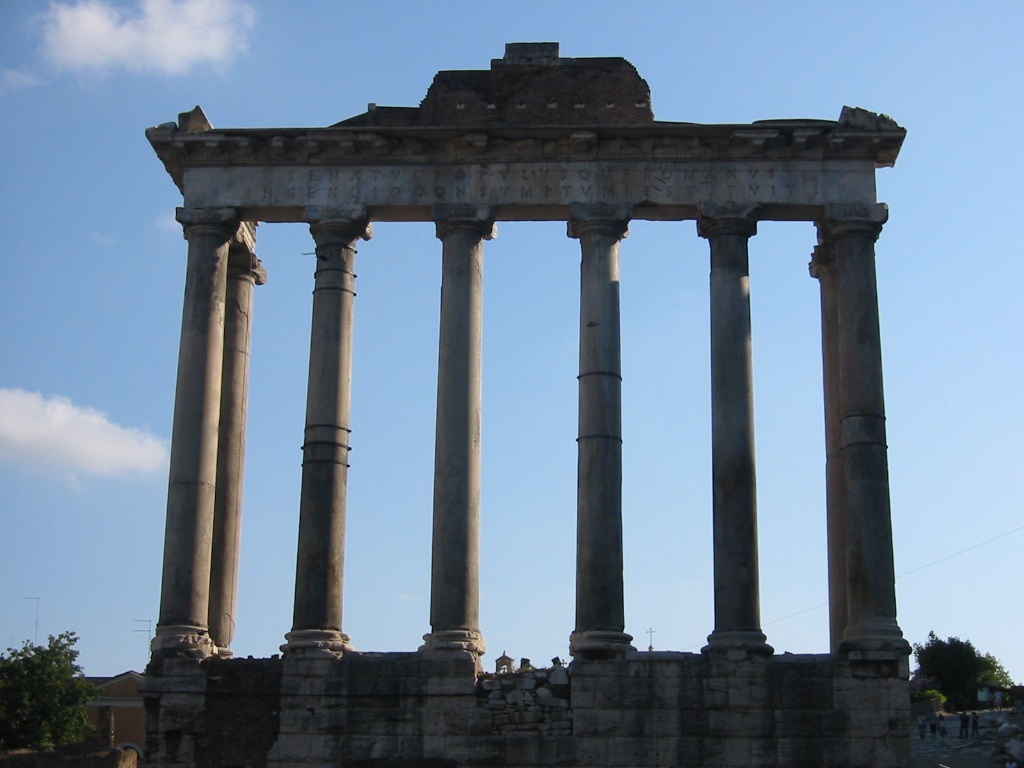
Follow along with Thor and me as your Italy virtual vacation continues with our ramble through the Forum, the heart of ancient Rome.
NOTE: Since travel is still on hold with the pandemic continuing, I’ve started a new blog series offering a virtual vacation and time-travel to my first big trip with Thor in 2008. Italy! Starting with highlight photos posted here on Saturday, Jan. 30, I’ll continue every week. Join us in Rome, Florence, Cinque Terre, Venice, and Milan. Buon viaggio!
We broke off our exploration last week at the Temple of Vesta, where those brave Vestal Virgins kept the sacred flame alive to ensure Rome’s security. Now let’s take a look upward at the Palatine Hill that overlooks the Forum. The cruel emperor Caligula built a sprawling palace atop the hill, which overflowed into the Forum behind the Temple of Castor and Pollux:
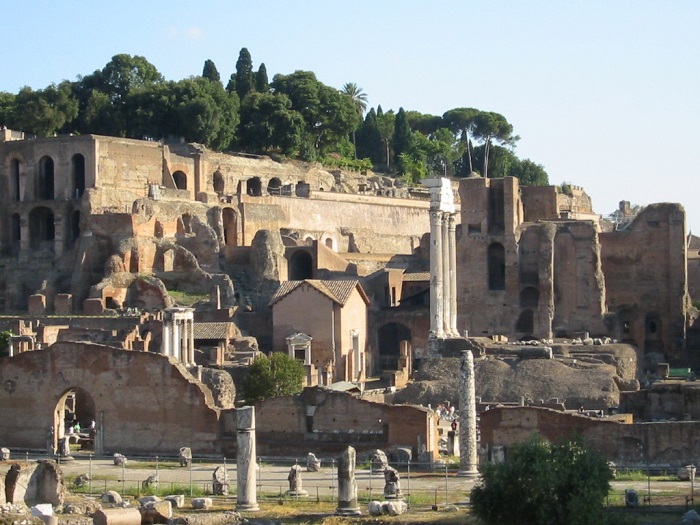
Atop the hill, not much remains of extensive buildings and gardens, as well as the Circus Maximus that hosted the famous chariot races.
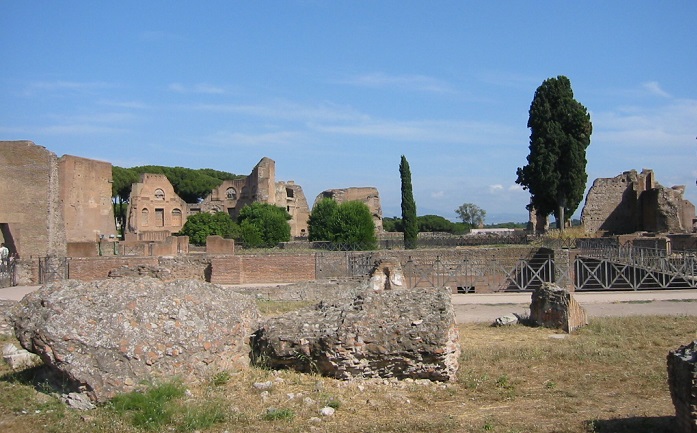
But the edge of the Palatine Hill offers an excellent overview of the Forum and beyond:
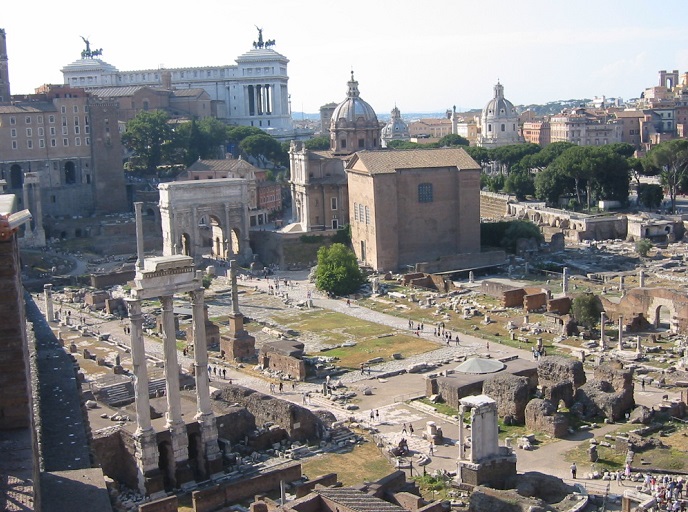
The main square was surrounded by temples, law courts, government buildings, and triumphal arches. The legend of twin brothers Romulus (Rome) and Remus holds that they were orphaned and raised by a she-wolf on top of Palatine Hill. Romulus then founded Rome. The ancient city’s population exceeded one million at its height, more than any city until London and Paris in the 19th century.
Let’s continue our ramble with the Temple of Castor and Pollux:
The three Corinthian columns (left, in photo above) are all that remain of an important temple, one of city’s oldest. Like many of the Forum buildings, it was rebuilt more than once after invasions and fires. The first version was built in the fifth century B.C. to commemorate the Roman victory over the Tarquin, the Etruscan king who had occupied the area. According to legend, the twin brothers Castor and Pollux watered their horses here after the battle, at the Sacred Spring of Juturna.
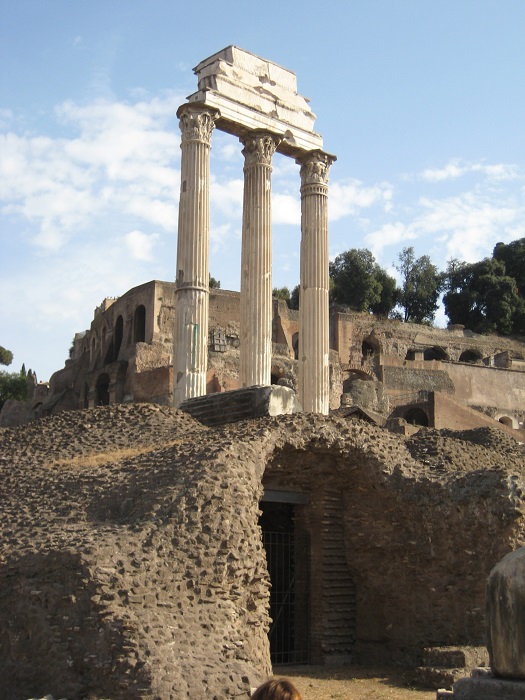
This temple continued to honor the Cult of the Dioscuri, the sons of Jupiter (Greek Zeus) and Leda, imported from Greece like so much of Roman religion and culture. These remaining Corinthian columns were erected in the first century. The front steps were a place for free speech by citizens.
On to the Temple of Saturn:
This is the Forum’s oldest temple, built in 497 BC. It sheltered a simple wooden statue of the god, but the statue’s hollow pedestal held the state treasury, booty collected by conquering generals. Saturn, renamed from Greek Titan Kronus, was the father of Jupiter (Greek Zeus) and the god of generation, dissolution, plenty, wealth, agriculture, periodic renewal and liberation. Saturn’s mythological reign was depicted as a Golden Age of plenty and peace.
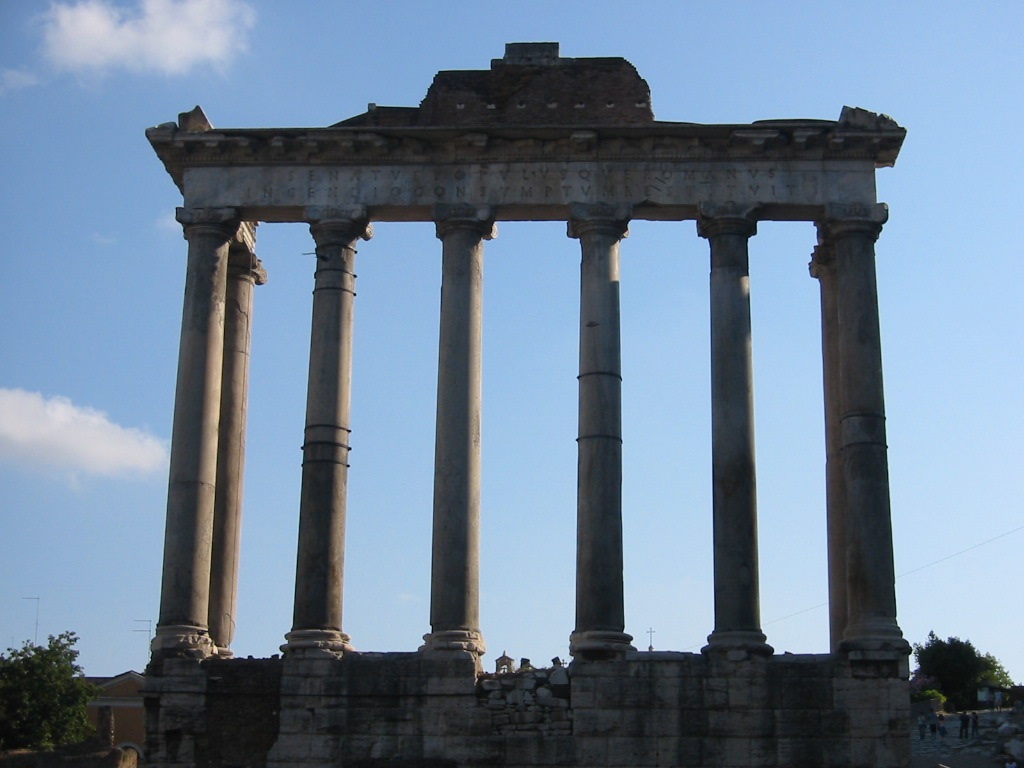
The Golden Age supposedly had no slavery or war or private property, so Saturn’s worship appealed to lower and slave classes. Every year from the 17th to 23rd of December, the Saturnalia festival offered a week of sacrifices, feasting, and fun. The normal social order turned topsy-turvy, as slaves and commoners could drink and dine with, and sometimes be served by, their masters. No prisoners were punished, and no wars declared. A King of Saturnalia (like the later “Lord of Misrule” in Europe) was elected by lot, and gave absurd orders that the crowd had to obey, like dunking someone pompous in a fountain. Shouts of “Io Saturnalia,” descended from Greek Dionysian revels, filled the streets.
Even older, the Umbilicus Urbis:
This small, rounded brick ruin stands near the Temple of Saturn. It marks the location of the “navel of the city,” considered the center of the cosmos. I can’t help wondering if this concept is yet another borrowing from the Greeks — their “omphalos” or center of the world at the Oracle of Delphi. The rounded brick structure is visible below, appearing just in front of the Column of Phocas and partly obscured by the protective metal roofing at lower right.
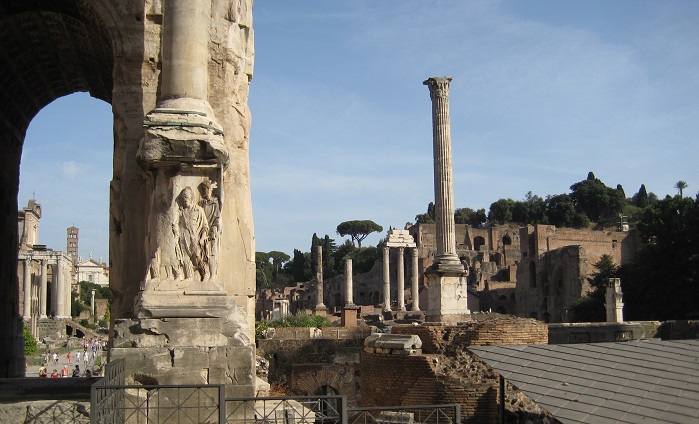
Roman religion was apparently based on the effort to create “pax deorum” or peace with the gods, through rituals and sacrifices. As I mentioned last week, they had hundreds of major and minor deities for every purpose, many from conquered regions. They were very superstitious and wary of signs such as lightning and thunder. Priests interpreted the will of gods by studying the internal organs of sacrificed animals, the flight of birds, and prophetic books. Most also believed in astrology, magic rites, the cult of deified emperors, near-deification of ancestors, and household gods. Thor and I continue the tradition with this replica “Lares and Penates” plaque — household gods and ancestors honored beside our door.
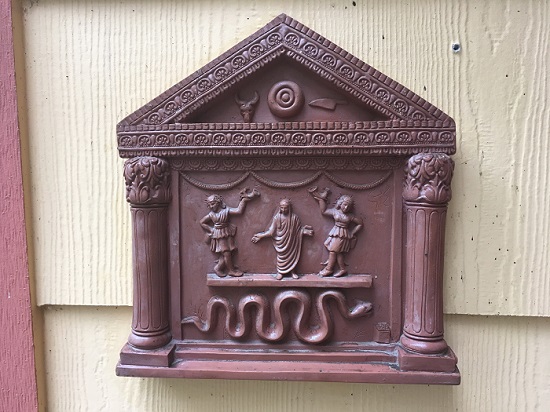
Beneath it all ran the Cloaca Maxima:
Last week I mentioned that one of the many deities was Venus Cloacina, the sewer goddess. The Cloaca Maxima, the ancient Roman sewer, is one of the oldest monuments in the Forum, appropriately foundational. Originally an open channel constructed in the sixth century B.C. by lining a stream bed with stone, it was enclosed in the third century with a stone barrel vault. Its main function at first was to carry off storm water from the Forum district to the nearby Tiber River. Later, public baths and latrines were connected to it, and much of its original masonry replaced by concrete.
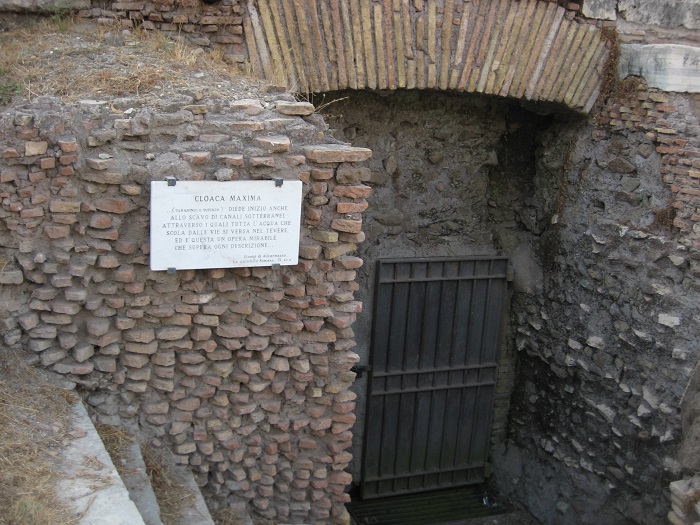
Nearby, I stepped into the lower chthonic levels to admire this carved stone spiral, but I have no memory of what it represented. Anyone know?
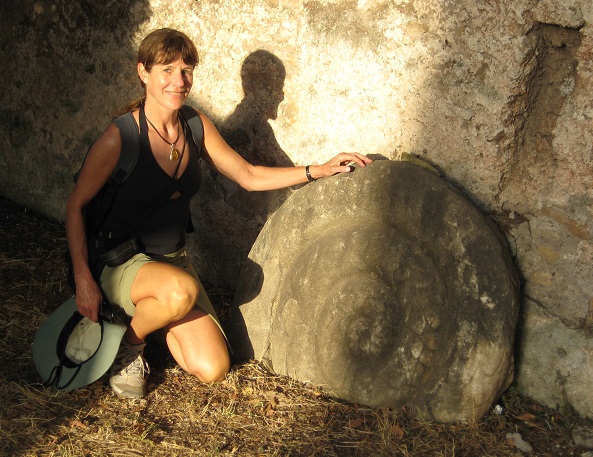
Back on the main level, at the west end of the Forum, is another major triumphal arch, The Arch of Septimius Severus.
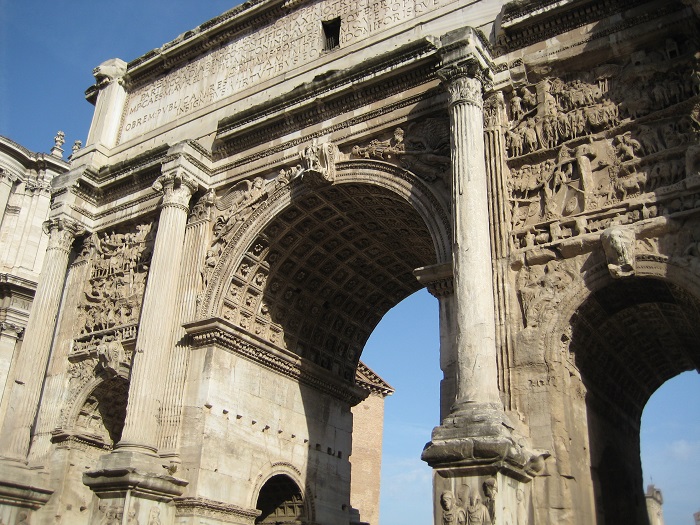
The Arch of Constantine that we saw in last week’s post, near the Colosseum, marks the east entrance of the Forum, and this arch marks the opposite west entrance of the Via Sacra (Sacred Way). This Arch of Septimius Severus is six stories high, with three bays, built in 203 A.D. It commemorated the emperor’s battles in Mesopotamia and victories over the Parthians. It has elaborate carvings of the battles, including “barbarian” prisoners and Roman soldiers, with a four-horse chariot along the central arch.
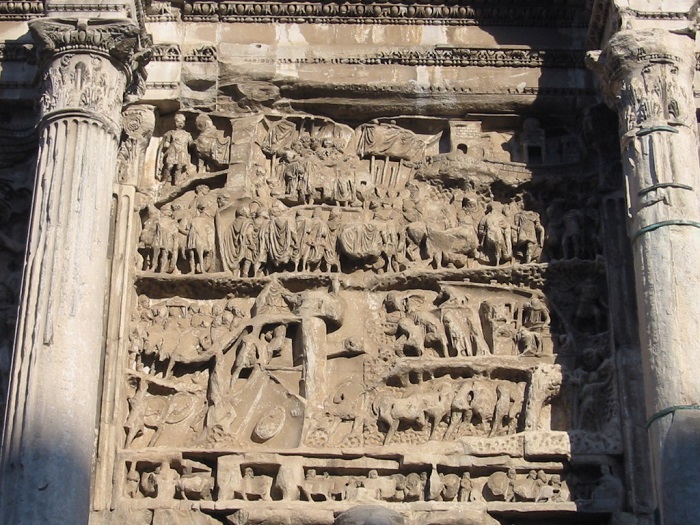
Next to the arch are the remains of the Rostrum, the Umbilicus Urbis, and the Column of Phocas:
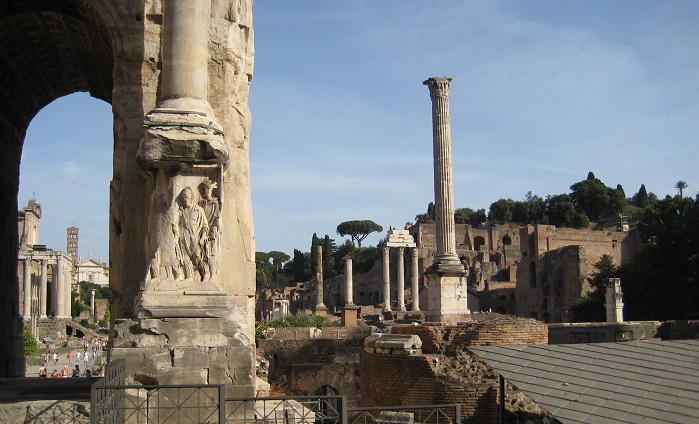
The Rostrum, to the right of the arch, was called the Speaker’s Corner. It was a raised platform 20 feet high and 80 feet long, decorated with statues, columns, and prows of ships captured in battle. Orators tried to draw a crowd here to sway the public, and Cicero famously railed against corruption. In front of it were trees and vines sacred to the realm: olives, figs, and wine grapes.
The tall Column of Phocas in the photo above was the last monument to be raised in the Forum. Built in 608 A.D., it was a gift from the powerful Byzantine Empire to the fallen empire of Rome. It commemorated the pagan Pantheon (which we’ll see in a later blog post) becoming a Christian church.
A bit of surviving marble pavement hints at the opulence of the Forum:
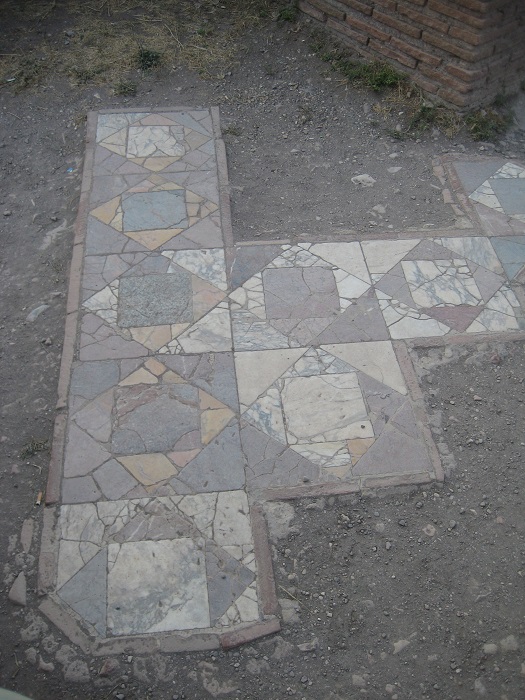
After the city was looted by Vandals, its population dropped to 10,000, and the ruined Forum was slowly covered by dirt. In the 1700s, the English historian Edward Gibbon spotted the tops of the few columns poking out of the ground here. He wrote “History of the Decline and Fall of the Roman Empire.”
Rambling through all this history during a heat wave in Rome just about toppled Thor, too. At six and a half feet, he has a lot of body mass to cool, and was suddenly teetering with incipient heat stroke. I spotted one of the life-saving “vapas” or natural spring fountains that pop up everywhere in the city with wonderfully cool, clean water from underground. I steered Thor over to dunk his head. After we lay in the sparse shade with cold, wet bandannas over our faces and necks, we were ready to continue our ramble.
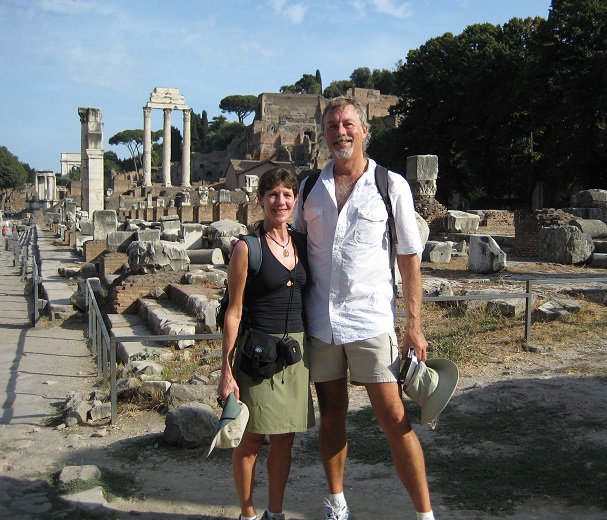
The vapa in the Forum wasn’t nearly this fancy, but here’s one we will later encounter in Florence:
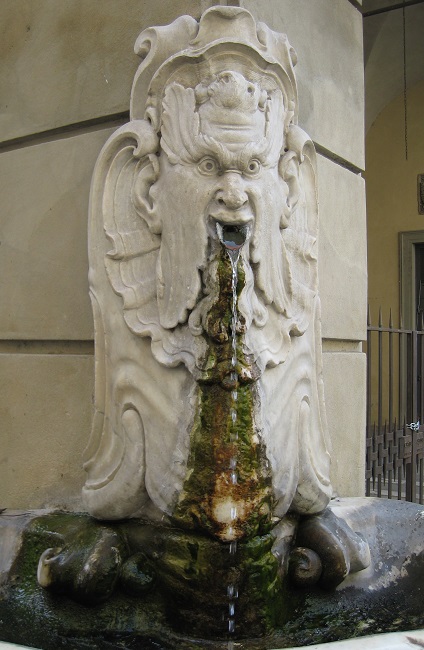
Next week: Ramble around Rome for some nightlife and more sites modern and old!
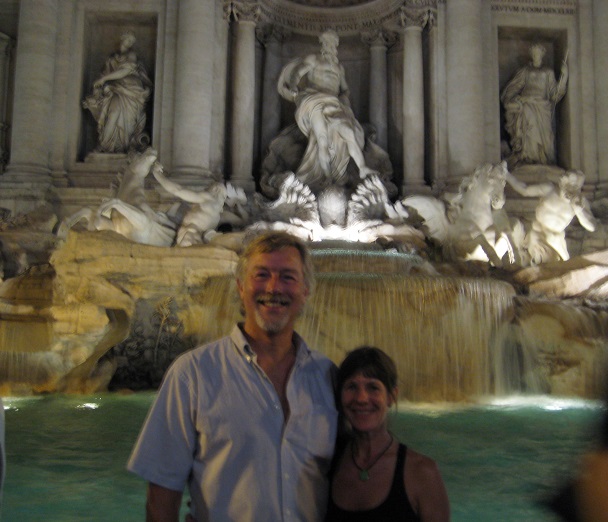
*****
You will find The Rambling Writer’s blog posts here every Saturday. Sara’s latest novel from Book View Cafe is available in print and ebook: The Ariadne Connection. It’s a near-future thriller set in the Greek islands. “Technology triggers a deadly new plague. Can a healer find the cure?” The novel has received the Chanticleer Global Thriller Grand Prize and the Cygnus Award for Speculative Fiction. Sara has recently returned from another research trip in Greece and is back at work on the sequel, The Ariadne Disconnect. Sign up for her quarterly email newsletter at www.sarastamey.com

1 thought on “The Rambling Writer’s Italy, part 4: The rest of the Roman Forum”